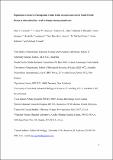Files in this item
Population structure of humpback whales in the western and central South Pacific Ocean as determined by vocal exchange among populations
Item metadata
| dc.contributor.author | Garland, Ellen C. | |
| dc.contributor.author | Goldizen, Anne W. | |
| dc.contributor.author | Lilley, Matthew S. | |
| dc.contributor.author | Rekdahl, Melinda L. | |
| dc.contributor.author | Garrigue, Claire | |
| dc.contributor.author | Constantine, Rochelle | |
| dc.contributor.author | Hauser, Nan Daeschler | |
| dc.contributor.author | Poole, M. Michael | |
| dc.contributor.author | Robbins, Jooke | |
| dc.contributor.author | Noad, Michael J. | |
| dc.date.accessioned | 2016-04-06T23:01:26Z | |
| dc.date.available | 2016-04-06T23:01:26Z | |
| dc.date.issued | 2015-07-14 | |
| dc.identifier | 208045337 | |
| dc.identifier | ec9e9430-4862-495c-807d-a65d4f1190eb | |
| dc.identifier | 000357981200026 | |
| dc.identifier | 84937073282 | |
| dc.identifier | 000357981200026 | |
| dc.identifier.citation | Garland , E C , Goldizen , A W , Lilley , M S , Rekdahl , M L , Garrigue , C , Constantine , R , Hauser , N D , Poole , M M , Robbins , J & Noad , M J 2015 , ' Population structure of humpback whales in the western and central South Pacific Ocean as determined by vocal exchange among populations ' , Conservation Biology , vol. 29 , no. 4 , pp. 1198-1207 . https://doi.org/10.1111/cobi.12492 | en |
| dc.identifier.issn | 0888-8892 | |
| dc.identifier.other | ORCID: /0000-0002-8240-1267/work/49580215 | |
| dc.identifier.uri | https://hdl.handle.net/10023/8568 | |
| dc.description | The study was supported by major grants from the Sea World Research and Rescue Foundation Inc., the Australian Department of the Environment, Water, Heritage and the Arts, and the Winifred Violet Scott Estate to M.J.N. and E.C.G. and from the International Fund for Animal Welfare (IFAW) to the South Pacific Whale Research Consortium (SPWRC). | en |
| dc.description.abstract | For cetaceans, population structure is traditionally determined by molecular genetics or photographically identified individuals. Acoustic data, however, has provided information on movement and population structure with less effort and cost than traditional methods in an array of taxa. Male humpback whales (Megaptera novaeangliae) produce a continually evolving vocal sexual display, or song, that is similar among all males in a population. The rapid cultural transmission (the transfer of information or behavior between conspecifics through social learning) of different versions of this display between distinct but interconnected populations in the western and central South Pacific region presents a unique way to investigate population structure based on the movement dynamics of a song (acoustic) display. Using 11 years of data, we investigated an acoustically based population structure for the region by comparing stereotyped song sequences among populations and years. We used the Levenshtein distance technique to group previously defined populations into (vocally based) clusters based on the overall similarity of their song display in space and time. We identified the following distinct vocal clusters: western cluster, 1 population off eastern Australia; central cluster, populations around New Caledonia, Tonga, and American Samoa; and eastern region, either a single cluster or 2 clusters, one around the Cook Islands and the other off French Polynesia. These results are consistent with the hypothesis that each breeding aggregation represents a distinct population (each occupied a single, terminal node) in a metapopulation, similar to the current understanding of population structure based on genetic and photo-identification studies. However, the central vocal cluster had higher levels of song-sharing among populations than the other clusters, indicating that levels of vocal connectivity varied within the region. Our results demonstrate the utility and value of using culturally transmitted vocal patterns as a way of defining connectivity to infer population structure. We suggest vocal patterns be incorporated by the International Whaling Commission in conjunction with traditional methods in the assessment of structure. | |
| dc.format.extent | 10 | |
| dc.format.extent | 573540 | |
| dc.language.iso | eng | |
| dc.relation.ispartof | Conservation Biology | en |
| dc.subject | Acoustic display | en |
| dc.subject | Humpback whale | en |
| dc.subject | Megaptera novaeangliae | en |
| dc.subject | Population structure | en |
| dc.subject | Song | en |
| dc.subject | South Pacific | en |
| dc.subject | Vocal | en |
| dc.subject | Whale culture | en |
| dc.subject | Canto | en |
| dc.subject | Cultivo de ballenas | en |
| dc.subject | Demostracion acustica | en |
| dc.subject | Estructura poblacional | en |
| dc.subject | Sur del Pacifico | en |
| dc.subject | Yubarta | en |
| dc.subject | GE Environmental Sciences | en |
| dc.subject | GC Oceanography | en |
| dc.subject | QH301 Biology | en |
| dc.subject | BDC | en |
| dc.subject | R2C | en |
| dc.subject.lcc | GE | en |
| dc.subject.lcc | GC | en |
| dc.subject.lcc | QH301 | en |
| dc.title | Population structure of humpback whales in the western and central South Pacific Ocean as determined by vocal exchange among populations | en |
| dc.type | Journal article | en |
| dc.contributor.institution | University of St Andrews. School of Biology | en |
| dc.contributor.institution | University of St Andrews. Sea Mammal Research Unit | en |
| dc.contributor.institution | University of St Andrews. Centre for Social Learning & Cognitive Evolution | en |
| dc.contributor.institution | University of St Andrews. Centre for Biological Diversity | en |
| dc.identifier.doi | 10.1111/cobi.12492 | |
| dc.description.status | Peer reviewed | en |
| dc.date.embargoedUntil | 2016-04-07 | |
| dc.identifier.url | https://onlinelibrary.wiley.com/doi/10.1111/cobi.12492/suppinfo | en |
This item appears in the following Collection(s)
Items in the St Andrews Research Repository are protected by copyright, with all rights reserved, unless otherwise indicated.

